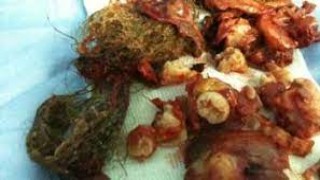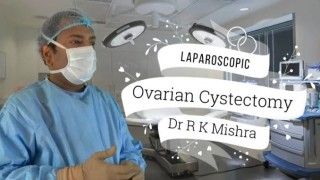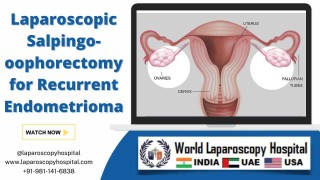Diagnostic laparoscopy for PCOD and tubal patency test with ovarian drilling
Add to
Share
2,226 views
Report
2 years ago
Description
Experience the precision of diagnostic laparoscopy as a powerful tool for both diagnosis and treatment in cases of Polycystic Ovary Syndrome (PCOS) and tubal patency assessment. This advanced minimally invasive procedure, combined with ovarian drilling, offers accurate evaluation and targeted intervention, providing hope for individuals seeking relief from the challenges of PCOS and fertility concerns. Diagnostic laparoscopy serves as a valuable diagnostic tool for PCOS, a hormonal disorder characterized by enlarged ovaries with multiple small cysts. By inserting a laparoscope through small incisions, the surgeon can directly visualize the pelvic organs, assessing the ovaries for cysts, fibroids, and other abnormalities. This precise evaluation aids in confirming the diagnosis and guiding subsequent treatment decisions. In addition to diagnosis, diagnostic laparoscopy can be combined with ovarian drilling to address PCOS-related infertility. Ovarian drilling involves the precise puncturing of the ovarian surface using a laser or electrocautery, aiming to restore ovulation and improve fertility outcomes. This technique helps to reduce the excess androgen production and improve hormonal balance, increasing the chances of natural conception or optimizing the success of assisted reproductive technologies. Furthermore, during diagnostic laparoscopy, a tubal patency test can be performed to assess the fallopian tubes' openness. This evaluation is crucial in determining the female partner's fertility potential, as blocked or damaged fallopian tubes can hinder natural conception. By introducing a dye or saline solution into the uterus and observing its flow through the fallopian tubes, the surgeon can assess tubal patency and identify any obstructions or abnormalities. The combination of diagnostic laparoscopy, ovarian drilling, and tubal patency testing offers a comprehensive approach to precision diagnosis and treatment. This minimally invasive technique minimizes surgical trauma, reduces post-operative discomfort, and accelerates recovery compared to traditional open surgery. Patients can expect faster return to daily activities and improved quality of life following the procedure. With the guidance of skilled reproductive specialists and gynecological surgeons, individuals with PCOS and fertility concerns can benefit from the precision and targeted intervention provided by diagnostic laparoscopy with ovarian drilling. The personalized approach ensures that each patient receives tailored care, optimizing their chances of achieving pregnancy and fulfilling their dream of starting or expanding a family. In summary, diagnostic laparoscopy for PCOS and tubal patency testing with ovarian drilling represents a significant advancement in the field of reproductive medicine. This precision diagnosis and treatment approach empowers individuals with PCOS to take proactive steps towards improving their fertility outcomes. By combining advanced technology, skilled surgical expertise, and personalized care, diagnostic laparoscopy offers hope and renewed possibilities for those navigating the challenges of PCOS and fertility concerns. With precision as its hallmark, diagnostic laparoscopy for PCOS and tubal patency testing with ovarian drilling offers a multifaceted approach to both diagnosis and treatment. This advanced procedure brings forth accurate evaluations and targeted interventions, providing individuals grappling with PCOS and fertility concerns with renewed hope and possibilities. Diagnostic laparoscopy serves as a powerful tool in the diagnosis of PCOS, a hormonal disorder characterized by enlarged ovaries and multiple small cysts. Through small incisions, a laparoscope is inserted, allowing direct visualization of the pelvic organs. This enables the surgeon to assess the ovaries for cysts, fibroids, and other abnormalities, leading to an accurate diagnosis and informed decision-making regarding subsequent treatment options. In addition to diagnosis, diagnostic laparoscopy can be combined with ovarian drilling to address the infertility challenges often associated with PCOS. Ovarian drilling involves the precise puncturing of the ovarian surface using techniques such as laser or electrocautery. This procedure aims to restore normal ovulation patterns by reducing the excess androgen production and promoting hormonal balance. By enhancing ovulatory function, ovarian drilling can increase the chances of natural conception or optimize the success of assisted reproductive technologies. During the diagnostic laparoscopy, a tubal patency test can also be performed to assess the openness and functionality of the fallopian tubes. This evaluation is crucial in determining the feasibility of natural conception, as blocked or damaged fallopian tubes can impede the fertilization process. By introducing a dye or saline solution into the uterus and observing its flow through the fallopian tubes, the surgeon can identify any obstructions or abnormalities, providing valuable information for further treatment planning. The combination of diagnostic laparoscopy, ovarian drilling, and tubal patency testing offers a comprehensive approach to precision diagnosis and treatment. The minimally invasive nature of laparoscopy ensures reduced surgical trauma, quicker recovery, and enhanced patient comfort compared to traditional open surgery. This approach not only facilitates faster return to daily activities but also contributes to an improved overall quality of life for individuals seeking relief from PCOS and fertility challenges. Under the guidance of experienced reproductive specialists and gynecological surgeons, individuals with PCOS and fertility concerns can benefit from the precision and personalized care provided by diagnostic laparoscopy with ovarian drilling. This tailored approach addresses the specific needs of each patient, maximizing the chances of achieving successful pregnancy and fulfilling their dreams of starting or expanding a family. In summary, diagnostic laparoscopy for PCOS and tubal patency testing with ovarian drilling represents a remarkable advancement in reproductive medicine. By combining state-of-the-art technology, expert surgical skills, and individualized care, this approach offers precise diagnosis, targeted treatment, and renewed hope for individuals navigating the complexities of PCOS and fertility struggles.
Similar Videos






